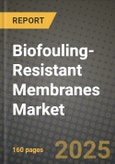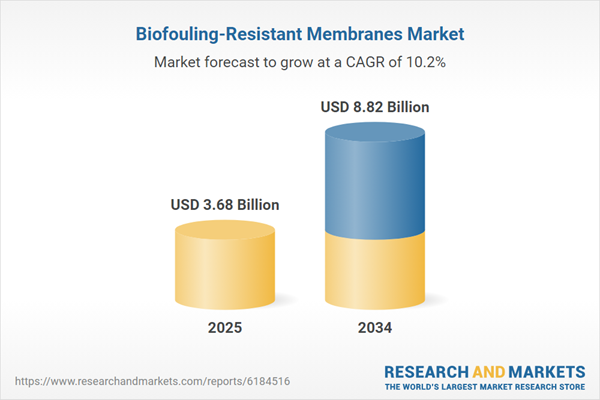Biofouling-Resistant Membranes Market
The biofouling‑resistant membranes market addresses a critical bottleneck in membrane‑based separation processes: the accumulation of biological matter (biofilms, microbes, extracellular polymeric substances) on membrane surfaces, which degrades flux, increases cleaning/chemical consumption, shortens lifetime and drives operational cost. These membranes incorporate anti‑fouling strategies - such as surface modification (hydrophilic/oleophobic coatings, zwitterionic chems), biocidal or biostatic additives, optimized pore‑structure, and hybrid architectures - to maintain high permeate yield, stability and reduced maintenance across applications. Key applications span desalination (RO/NF), municipal and industrial wastewater reuse, food & beverage processing, pharmaceutical/biotech water systems, gas separation and other process streams where fouling risk is elevated. Major trends include development of low‑fouling and self‑cleaning membranes, incorporation of nanoparticles or antimicrobial agents, growth of packaged skid‑units using fouling‑resistant modules, and increasing focus on lifecycle cost of membrane systems rather than just upfront cost. Drivers are rising water reuse mandates, tougher effluent quality requirements, growth of high‑fouling feed streams (e.g., industrial wastewater, seawater with high biological load), and desire to reduce downtime and chemical cleaning in membrane operations. The competitive landscape comprises membrane module manufacturers, treatment‑system integrators, anti‑fouling coating innovators and niche specialty chemical firms - success is determined by membrane performance (flux retention, fouling margin), robustness of coating/structure, service life, total cost of ownership, and manufacturing scalability. Other market dynamics include higher premium pricing for fouling‑resistant modules, regional cost/servicing differences, and the need to validate long‑term performance under real‑world fouling conditions.Biofouling-Resistant Membranes Market Key Insights
- Fouling burden translates to value levers: Operators recognise that biofouling not only reduces throughput but drives chemical cleaning, downtime and module change outs - membranes that demonstrably maintain flux and lower cleaning frequency become premium propositions.
- Surface modification technologies proliferate: Hydrophilic, zwitterionic, antimicrobial nanoparticulate and grafted polymer coatings are emerging as differentiators in the market, enabling membranes to resist microbial attachment and biofilm formation more effectively.
- Industrial/high fouling applications are growth hotspots: Sectors such as food & beverage, textile, pharmaceutical, and high TDS industrial wastewater streams present elevated fouling risk and hence a stronger business case for fouling resistant solutions.
- Desalination and high bio load seawater pose special demands: Membranes used in seawater RO or brackish water with high biological/organic load need advanced fouling resistance; these premium applications accelerate adoption of specialised modules.
- Retrofit & upgrade cycles favoured: Existing plants facing frequent cleaning and module change outs are increasingly considering retrofits with fouling resistant modules as a cost effective way to extend life and reduce OPEX.
- Lifecycle cost mindset gaining traction: Procurement shifts from purely CAPEX focus to OPEX lifecycle (cleaning chemicals, downtime, module life, energy) meaning higher upfront cost may be justified by lower running cost.
- Regional service and supply chain matter: Because fouling resistance often depends on module replacement, spare parts, support and monitoring, manufacturers with strong service footprint and regional supply offer competitive advantage.
- Digital monitoring integrates with fouling control: Sensors tracking transmembrane pressure, flux decline, chemical usage, combined with predictive analytics, support membranes designed for fouling resistance and improved maintenance scheduling.
- Cost premium and material caution remain barriers: Fouling resistant membranes typically command premium pricing and their coatings/structures add complexity; cost sensitive projects may delay adoption unless value case is clear.
- Innovation ecosystem is active: Partnerships among membrane makers, coating/chemical specialists and research institutes are growing; co development of low fouling membranes (e.g., using zwitterionic chemistry) signals future expansion and differentiation.
Biofouling-Resistant Membranes Market Reginal Analysis
North America
The North American market is supported by high standards of wastewater treatment, strong interest in water reuse/recycling, desalination in certain coastal states and industrial applications requiring high‑purity water. The fouling‑resistant membrane segment is gaining traction via retrofit demand, industrial reuse (food & beverage, pharma) and modular packaged systems. Buying decisions favour proven performance, service support and low‑lifetime cost; premium pricing is more acceptable in regulated or high‑stakes environments.Europe
Europe features mature municipal treatment markets, strong regulatory demands for reuse and discharge quality, and advanced industrial sectors (chemicals, healthcare) that demand reliable water and process separation systems. Fouling‑resistant membranes are favoured in retrofit scenarios and compact reuse plants, especially where space or downtime constraints exist. Material sustainability, certification and long‑term performance are important differentiators.Asia‑Pacific
Asia‑Pacific represents the fastest growth region for fouling‑resistant membranes, driven by rising wastewater flows, desalination growth, water‑scarce geographies, expanding industrial clusters and reuse mandates. Many facilities face high fouling load (industrial discharges, tropical climates) making the value proposition for fouling‑resistant modules very strong. Local manufacturing, cost competitiveness and service networks are critical for market gain.Middle East & Africa
In the Middle East & Africa region, water scarcity, growing desalination and reuse projects make fouling‑resistant membranes highly relevant. High‑bio‑load seawater, remote installations and harsh conditions favour modules that reduce cleaning and servicing. However, upfront cost sensitivity and service infrastructure gaps can slow adoption; vendors offering bundled service/monitoring models have an edge.South & Central America
The market in South & Central America is shaped by growing urbanisation, industrial wastewater demand and reuse initiatives, although regulatory and funding constraints are more pronounced compared to mature markets. Fouling‑resistant membranes present value in retrofit and high‑fouling scenarios, but adoption is moderated by cost, supply‑chain and local support. Service‑oriented business models and value‑based selling assist market penetration.Biofouling-Resistant Membranes Market Segmentation
By Membrane Type
- Reverse Osmosis (RO)
- Ultrafiltration (UF)
- Nanofiltration (NF)
- Microfiltration (MF)
- Membrane Bioreactor (MBR)
By Material & Coating Technology
- Polyamide Thin-Film Composite (TFC) Membranes
- Polyethersulfone (PES) & Polysulfone (PSU) Membranes
- Ceramic & Silicon Carbide Membranes
- Biomimetic & Aquaporin-Based Membranes
- Functional Coatings
By Application
- Seawater Desalination
- Brackish Water Treatment
- Municipal Water & Wastewater Treatment
- Industrial Wastewater Treatment
- Pharmaceuticals & Biotechnology
- Food & Beverage Processing
Key Market players
DuPont, Toray Industries, Asahi Kasei, LG Chem, Koch Separation Solutions, Hydranautics, SUEZ, Pall Corporation, Aquaporin, NX Filtration, Membranium, Pentair, Parker Hannifin, Alfa Laval, Mitsubishi ChemicalBiofouling-Resistant Membranes Market Analytics
The report employs rigorous tools, including Porter’s Five Forces, value chain mapping, and scenario-based modelling, to assess supply-demand dynamics. Cross-sector influences from parent, derived, and substitute markets are evaluated to identify risks and opportunities. Trade and pricing analytics provide an up-to-date view of international flows, including leading exporters, importers, and regional price trends.
Macroeconomic indicators, policy frameworks such as carbon pricing and energy security strategies, and evolving consumer behaviour are considered in forecasting scenarios. Recent deal flows, partnerships, and technology innovations are incorporated to assess their impact on future market performance.Biofouling-Resistant Membranes Market Competitive Intelligence
The competitive landscape is mapped through proprietary frameworks, profiling leading companies with details on business models, product portfolios, financial performance, and strategic initiatives. Key developments such as mergers & acquisitions, technology collaborations, investment inflows, and regional expansions are analyzed for their competitive impact. The report also identifies emerging players and innovative startups contributing to market disruption.
Regional insights highlight the most promising investment destinations, regulatory landscapes, and evolving partnerships across energy and industrial corridors.Countries Covered
- North America - Biofouling-Resistant Membranes market data and outlook to 2034
- United States
- Canada
- Mexico
- Europe - Biofouling-Resistant Membranes market data and outlook to 2034
- Germany
- United Kingdom
- France
- Italy
- Spain
- BeNeLux
- Russia
- Sweden
- Asia-Pacific - Biofouling-Resistant Membranes market data and outlook to 2034
- China
- Japan
- India
- South Korea
- Australia
- Indonesia
- Malaysia
- Vietnam
- Middle East and Africa - Biofouling-Resistant Membranes market data and outlook to 2034
- Saudi Arabia
- South Africa
- Iran
- UAE
- Egypt
- South and Central America - Biofouling-Resistant Membranes market data and outlook to 2034
- Brazil
- Argentina
- Chile
- Peru
Research Methodology
This study combines primary inputs from industry experts across the Biofouling-Resistant Membranes value chain with secondary data from associations, government publications, trade databases, and company disclosures. Proprietary modeling techniques, including data triangulation, statistical correlation, and scenario planning, are applied to deliver reliable market sizing and forecasting.Key Questions Addressed
- What is the current and forecast market size of the Biofouling-Resistant Membranes industry at global, regional, and country levels?
- Which types, applications, and technologies present the highest growth potential?
- How are supply chains adapting to geopolitical and economic shocks?
- What role do policy frameworks, trade flows, and sustainability targets play in shaping demand?
- Who are the leading players, and how are their strategies evolving in the face of global uncertainty?
- Which regional “hotspots” and customer segments will outpace the market, and what go-to-market and partnership models best support entry and expansion?
- Where are the most investable opportunities - across technology roadmaps, sustainability-linked innovation, and M&A - and what is the best segment to invest over the next 3-5 years?
Your Key Takeaways from the Biofouling-Resistant Membranes Market Report
- Global Biofouling-Resistant Membranes market size and growth projections (CAGR), 2024-2034
- Impact of Russia-Ukraine, Israel-Palestine, and Hamas conflicts on Biofouling-Resistant Membranes trade, costs, and supply chains
- Biofouling-Resistant Membranes market size, share, and outlook across 5 regions and 27 countries, 2023-2034
- Biofouling-Resistant Membranes market size, CAGR, and market share of key products, applications, and end-user verticals, 2023-2034
- Short- and long-term Biofouling-Resistant Membranes market trends, drivers, restraints, and opportunities
- Porter’s Five Forces analysis, technological developments, and Biofouling-Resistant Membranes supply chain analysis
- Biofouling-Resistant Membranes trade analysis, Biofouling-Resistant Membranes market price analysis, and Biofouling-Resistant Membranes supply/demand dynamics
- Profiles of 5 leading companies - overview, key strategies, financials, and products
- Latest Biofouling-Resistant Membranes market news and developments
Additional Support
With the purchase of this report, you will receive:- An updated PDF report and an MS Excel data workbook containing all market tables and figures for easy analysis.
- 7-day post-sale analyst support for clarifications and in-scope supplementary data, ensuring the deliverable aligns precisely with your requirements.
- Complimentary report update to incorporate the latest available data and the impact of recent market developments.
This product will be delivered within 1-3 business days.
Table of Contents
Companies Mentioned
- DuPont
- Toray Industries
- Asahi Kasei
- LG Chem
- Koch Separation Solutions
- Hydranautics
- SUEZ
- Pall Corporation
- Aquaporin
- NX Filtration
- Membranium
- Pentair
- Parker Hannifin
- Alfa Laval
- Mitsubishi Chemical
Table Information
| Report Attribute | Details |
|---|---|
| No. of Pages | 160 |
| Published | November 2025 |
| Forecast Period | 2025 - 2034 |
| Estimated Market Value ( USD | $ 3.68 Billion |
| Forecasted Market Value ( USD | $ 8.82 Billion |
| Compound Annual Growth Rate | 10.2% |
| Regions Covered | Global |
| No. of Companies Mentioned | 15 |









